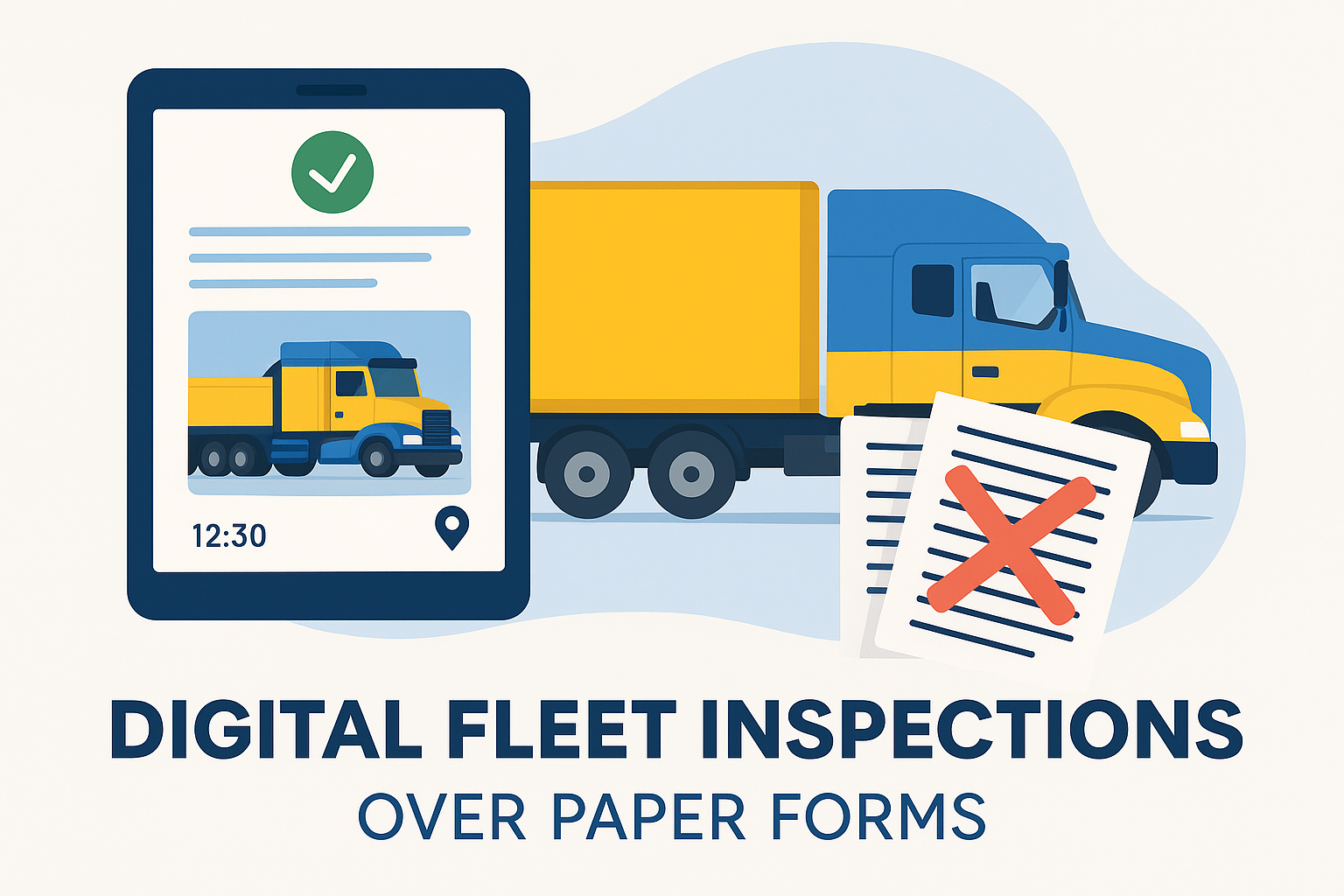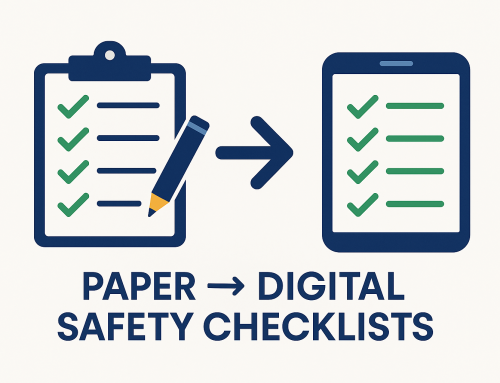Digital Fleet Inspections Australia: 10 Proven Benefits Over Paper Checklists
If your fleet still relies on paper forms, it’s time to rethink inspections. The 2024 National Roadworthiness Survey (see the Final Report PDF) found that roughly one in four heavy vehicles and combinations did not pass inspection, with brake defects the most common issue. Moving to digital fleet inspections helps operators increase completion quality, surface defects faster, and stay audit-ready under Australian regulations.
Quick Highlights
- NHVR-aligned daily checks with audit-ready digital records
- Defects logged with photos, time and location for indisputable evidence
- Instant alerts and Action Register follow-through reduce risk and downtime
- Paperless workflows that cut admin load and improve visibility
Table of Contents
Why Australian Fleet Inspections Matter
Heavy vehicle daily checks are fundamental to safety and compliance in Australia. Missing a defect can lead to:
- Fines up to $8,250 for unsafe vehicle operation under Section 89 HVNL, with infringement penalties of $825 — see Section 89 HVNL
- Unplanned downtime and costly breakdowns
- Audit risk, including failed checks and corrective actions
- Serious incidents that could have been prevented with a simple daily check
The 2024 NRS confirms that braking systems remain the leading defect category—underscoring why digital fleet inspections with evidence capture make a real difference.
Traditional Paper vs Digital Inspections: The Real Cost
Paper processes are slow, error-prone, and hard to audit. Common challenges include:
- Administrative burden collating, filing, and re-keying data
- Printing and storage overheads that accumulate through the year
- Lost or illegible paperwork creating compliance gaps
- Delayed defect reporting that leads to reactive maintenance
- “Pencil whipping” (rushed, incomplete forms) that hides real risk
10 Benefits of Digital Fleet Inspections with DIGI CLIP
1) Faster, Consistent Daily Checks
Structured prompts guide drivers step-by-step and reduce handwriting and re-entry. Results appear instantly in your dashboard.
2) Photo Evidence with Geo-Time Stamping
Capture defects with photos, time, and location to create audit-ready records and support insurance claims.
3) No Skipped Checks
Mandatory fields ensure every item is addressed—no missed steps or illegible handwriting.
4) Lower Admin Load
Paper handling and manual entry are removed, so teams spend more time fixing issues and less time filing.
5) Instant Defect Alerts
Failed items trigger notifications so maintenance or supervisors can act before vehicles leave the yard.
6) Audit-Ready Records in the Cloud
Inspection history, photos, signatures, and actions are stored securely and retrievable within seconds during audits.
7) Fleet-Wide Visibility
Dashboards track completion rates, defect trends, and repeat faults to inform proactive maintenance.
8) Sustainability Benefits
Paperless workflows reduce printed forms and storage, supporting sustainability goals.
9) NHVR-Aligned Templates
Pre-configured daily check templates cover mandatory items under NHVAS Maintenance Management. For detailed standards, see the NHVAS Business Rules & Standards (PDF).
10) Maintenance Integration
Failed checks link automatically to the Action Register so nothing falls through the cracks.
NHVR Compliance Made Simple
- NHVAS Maintenance Management – daily check requirement (see standards above)
- Section 89 of the HVNL – prohibits operation of unsafe vehicles
- Chain of Responsibility (CoR) – digital evidence supports role-based obligations
- Audit-ready trails – time, user, and location stamps build credible records
Comparison: Paper vs Digital Checklists
| Aspect | Paper Inspections | Digital Fleet Inspections (DIGI CLIP) |
|---|---|---|
| Completion Quality | Skipped items, illegible handwriting | Mandatory fields, structured prompts, clear evidence |
| Defect Reporting | Delayed until end of shift/day | Instant alerts with photos and location |
| Audit Readiness | Time-consuming filing and retrieval | Searchable records and PDFs in seconds |
| Cost & Admin | Printing, storage, double handling | Paperless, minimal re-entry, streamlined workflows |
| Compliance | Gaps and lost forms create risk | Evidence-rich trails for NHVR and CoR |
| Action Follow-Through | Manual tracking; easy to miss items | Action Register ties defects to close-out |
ROI Example (Illustrative)
“Illustrative” indicates indicative figures only. Many fleets report five-figure annual savings from reduced admin, fewer breakdowns, and better compliance. Your actual ROI depends on fleet size, duty cycles, and maintenance maturity—DIGI CLIP surfaces the data to measure it.
Mini Case Note
“Digi Clip mobile forms provides a seamless, reliable and easy recording of many aspects of safety procedures. With a mobile and portable workforce, ideal to ensure compliance to many aspects of safety systems. The 'App' is user friendly, with easy recovery of required documents no matter your digital expertise! ” — Andrew, Group BDM - Logistics and Supply Chain
FAQs
Are daily heavy vehicle checks mandatory in Australia?
Daily checks are required under NHVAS Maintenance Management and support obligations under the HVNL and Chain of Responsibility. Digital records make compliance easier to evidence.
Is DIGI CLIP aligned with NHVR expectations?
Yes. Templates reflect mandatory daily check items and are customisable by vehicle class. DIGI CLIP helps create complete, time-stamped, user-attributed, and location-stamped evidence for NHVR inspections.
What happens if a driver is offline?
Inspections can be completed offline. Data is securely stored on the device and uploaded once connectivity is restored.
Can I attach photos and comments to defects?
Yes. Photos, comments, and signatures are captured in-app. Geo-time stamps provide strong evidence for auditors and insurers.
How does the Action Register help?
Every defect can create or link to an action with due dates, assignees, and status. Dashboards provide visibility so nothing slips through the cracks.
How long are records retained?
DIGI CLIP stores inspection records in the cloud; you can export evidence to meet internal policies and regulator expectations for multi-year retention.
About DIGI CLIP Mobile Forms
DIGI CLIP is a mobile checklist and inspection app that simplifies safety, compliance, and operational reporting. Designed for industries like transport, warehousing, agriculture, and construction, DIGI CLIP replaces paper forms with real-time digital checklists. Built-in photo capture, automated alerts, geo-time stamping, and an Action Register ensure nothing gets missed.
Why try DIGI CLIP? Because safety actions don’t count if you can’t prove them. Start your free trial—no credit card needed—and see how simple compliance can be.
Further Reading
- Digital checklists for workplace safety
- Top benefits of digital inspection apps for compliance
- From paper to digital: compliance tools for SMBs
- Industry-specific digital checklists: customised compliance
Authoritative references: National Roadworthiness Survey (NHVR overview) · 2024 NRS Final Report (PDF) · NHVAS Maintenance Management · NHVAS Business Rules & Standards (PDF) · Heavy Vehicle National Law (AustLII) · HVNL s.89 – Unsafe vehicles
Conclusion
Paper forms struggle to keep pace with modern compliance demands. By adopting digital fleet inspections, Australian operators strengthen daily checks, capture evidence at the source, and build audit-ready records that stand up to scrutiny. DIGI CLIP’s NHVR-aligned templates, offline capability, and Action Register help you surface defects sooner and close them out faster—reducing risk and downtime.
If you’re ready to improve safety outcomes, streamline compliance, and modernise inspections, start today.
If you liked this post, why not share it!








Leave A Comment